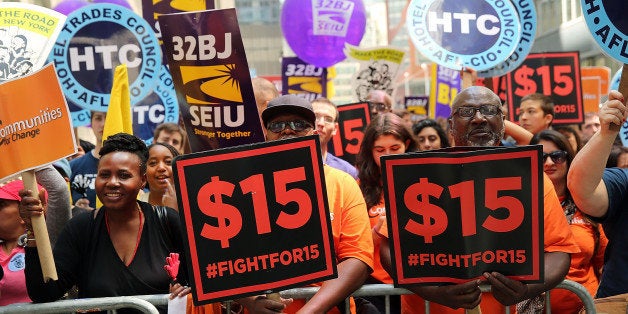
The "Fight for $15" -- a nationwide movement to raise the minimum wage to $15 per hour --has taken a lot of "incoming" from critics. Today, it's Bob Samuelson's turn, who under a column titled "minimum wage madness" argues that a substantial minimum wage increase would cause "job losses [to] mount" and constitute an economic "blunder."
The critics, including Samuelson, make one important point. Should the nation adopt a $15 minimum wage tomorrow, the share of workers affected in places with relatively low wages would be far larger than under any other historical increase. This scenario would increase the chances of unintended consequences, like loss of jobs or hours of work, for those affected by the policy.
But as far as we can see, no one is proposing $15 tomorrow. All the proposals we know of phase in gradually over the course of numerous years. For example, the $12 minimum wage proposal Samuelson cites reaches that level in 2020, after which it is indexed to the median wage. To be fair, it's of course the case that larger increases reach more workers, and that both $12 and especially $15 would affect larger shares than many prior increases. But that also depends on the length of their phase-ins and the characteristics of the labor market in the place where the increase is to take place, criteria that critics typically ignore.
Though the proposal for the $12 federal minimum (the Raise the Wage Act) has been endorsed by President Obama and there are prominent advocates for a national minimum of $15 (e.g., presidential candidate Bernie Sanders), the vast majority of the action is at the sub-national level. Cities like Seattle and San Francisco, with relatively high wages and prices, are slowly phasing in their increases. San Francisco, with a minimum wage currently at $12.25 an hour, won't get to $15 until July 1, 2018, and Seattle, currently at $11, won't reach $15 until January 2019. The $15 minimums in Los Angeles and DC (if adopted) won't be fully phased-in until 2020, providing businesses with some time to adjust and, because of wage growth between now and then, affecting a smaller share of workers than if the increase were to go into effect today.
Samuelson's analysis is also one-sided. He cites potential job losses; he ignores the much larger number of wage gainers. For example, Samuelson cites a widely-discussed Congressional Budget Office analysis of the prospective impacts of raising the minimum wage to $10.10 by 2016. He notes that CBO estimated that 500,000 workers would lose or not get jobs without mentioning CBO's finding - in the same report - that 24.5 million would get raises (16.5 million directly and 8 million indirectly).
In fact, here's a useful rule of thumb when evaluating the arguments of minimum wage critics - when someone, as Samuelson did today, emphasizes job loss possibilities while ignoring the often much larger beneficiary side of the equation, you know they're trying to mislead. We should by no means write off potential negatives. But we cannot begin to understand what's going on with the national movement if we ignore the positives--millions of people rationally support large increases because they expect to gain from them.
That's rationality, not "madness."
In this regard, analysts for and against increases in the minimum wage must consider the policy from the perspective of low-wage workers. Specifically, how do the risks of unintended consequences compare to the risks of continuing to earn poverty-level wages? Or, put differently, does the potential gain from increased wages make it worth venturing into territory, like a $15 wage floor, that is outside the sample of the moderate increases that have prevailed thus far?
In fact, there are two main reasons why low-wage workers may rationally support even large increases in the minimum wage. First, even the most pessimistic employment estimates from the literature tend to imply disemployment effects that rise more slowly than minimum wage increases. Thus, even if they buy conservative job-loss estimates, low-wage workers may well conclude that they're more likely to come out ahead with a higher minimum wage. Second, they may also recognize that even if they do lose work and could possibly face a longer job search, a minimum wage increase would mean they could eventually expect a higher-quality job.
The bottom line: low-wage workers around the country have sparked a movement for large minimum wage increases for a reason. And their proposed increases are phased in gradually over several years. It might behoove some of those commenting from the sidelines to stop calling them crazy and start entertaining the idea that they might actually know what they're doing.
This post originally appeared at Jared Bernstein's On The Economy blog.